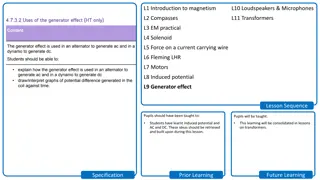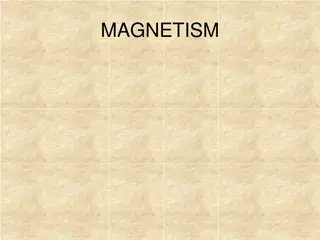Investigating Electricity and Magnetism Properties
Students will explore the properties of electricity and magnetism, including static electricity, electron flow, voltage, resistance, current, and applications of magnetism. Electricity is described as the flow of electrical power obtained from various energy sources. The concept of electrical energy associated with electric charges, atoms, protons, electrons, and neutrons is explained, along with how atoms become charged by gaining or losing electrons. Electric force, defined as the attraction or repulsion between electrically charged objects, is also discussed.
Download Presentation

Please find below an Image/Link to download the presentation.
The content on the website is provided AS IS for your information and personal use only. It may not be sold, licensed, or shared on other websites without obtaining consent from the author.If you encounter any issues during the download, it is possible that the publisher has removed the file from their server.
You are allowed to download the files provided on this website for personal or commercial use, subject to the condition that they are used lawfully. All files are the property of their respective owners.
The content on the website is provided AS IS for your information and personal use only. It may not be sold, licensed, or shared on other websites without obtaining consent from the author.
E N D
Presentation Transcript
Electricity Chapter 20
GA Performance Standards SPS10. Students will investigate the properties of electricity and magnetism. SPS10. A. Investigate static electricity in terms of Friction Induction conduction SPS10. B. Explain the flow of electrons in terms of Alternating and direct current The relationship among voltage, resistance, and current Simple series and parallel circuits SPS10. C. Investigate applications of magnetism and/or its relationship to the movement of electrical change as it relates to Electromagnets Simple motors Permanent magnets
What is Electricity?
Electricity is the flow of electrical power or charge. It is a secondary energy source which means that we get it from the conversion of other sources of energy, like coal, natural gas, oil, nuclear power and other natural sources, which are called primary sources.
Electrical energy is the energy associated with electric charges Electric charge is a property that causes subatomic particles such as protons and electrons to attract or repel each other Electric Charge
Atoms contain particles called protons, neutrons and electrons. PROTON ELECTRON NEUTRON
Atoms basics Protons have a positive charge and electrons have a negative charge An atom has a cloud of negatively charged electrons surrounding the positively charged nucleus. The atom is neutral sense it has equal numbers of protons and neutrons An excess or shortage of electrons produces a net electric charge
In most atoms, the number of protons equals the number of electrons and the charges cancel each other out, and the atom has no net charge. + + + + + - - - - - Atoms become charged by gaining or losing electrons. BEFORE AFTER +-+-+-+- = (0) if it loses an electron +-+-+-+ = (+) positive charge +-+-+-+- - = (-) +-+-+-+- = (0) if it gains an electron negative charge
Electric force Electric force is the force of attraction or repulsion between electrically charged objects electric force between two objects is proportional to the net charge on each object, Electric force between two objects is inversely proportional to the square of the distance between them
Electric force Example: doubling the charge on one object doubles the electric force Example: doubling the distance between the objects the electric force is one fourth as strong Inside an atom electric forces are stronger then gravitational force, but on large scale matter is mostly neutral and electric forces are close to zero.
clipart: Atoms Electrically charged objects obey the following rules:
1. Law of conservation of charge: Charge may be transferred from object to object, but it cannot be created nor destroyed
Electric Field Electric field is a field in a region of space that exerts electric forces on charged particles the electric field is produce by electric charges or by changes magnetic fields the strength of an electric field depends on the amount of charge that produces the field and on the distance from the field. The more net charge an object has the greater is the force on it
Electric field Positive- Out Negative- In - + Electric field depends on: distance and charge The electric field around a positive charge points outward The electric field around a negative charge points inward
4. Electrons move easily through conductors: GOLD METALS SILVER COPPER
5. Electrons do not move easily through insulators: PLASTIC WOOD RUBBER GLASS
Which part of the material is the conductor? Which part of the material is the Insulator?
Types of electricity 1. Static electricity is the study of the behavior of electric charges, including how charge is transferred between objects (in three ways). Have you ever felt a shock when you touched an object after walking across a carpet? A stream of electrons jumped to you from that object. This is called static electricity. Static Electricity Video
Transferring Electric Charge 1. charge transfer by friction (rubbing) Static electricity transferred by rubbing a balloon on the boy s hair
Transferring Electric Charge 2. Charge transfer by contact (direct contact) Van de Graaff generator machine that produces static electricity
Transferring Electric Charge 3. charge transfer by induction (without contact) Shocking your hand on a doorknob before touching it Being struck by lightning b/c you are standing near a tree.
Types of electricity 2. Electric Current is a continuous flow of electrons. example: wall outlet
Electric Current and Ohm s Law
How do we use electricity? Picture of CW-XC183HU We use electricity to do many jobs for us -- from lighting and heating/cooling our homes, to powering our televisionsand computers. Electricity is a controllable and convenient form of energy used in the applications of heat, light and power.
Why its important!!!!! Without electric current, many devices would not exist, including telephones, personal computers, and lightning!
A. The flow of charges through a wire or conductor is called electric current. 1. Current is usually the flow of electrons. 2. Electric current is measured in amperes (A). 3. Charges flow from high voltage to low voltage. a. Voltage difference- the push that causes charges to move, measured in volts (V). 4. For charges to flow, the wire must always be connected in a closed path, or circuit.
2 types of electric current (DC/AC) Direct Current (DC) Flow of electric charge in only one direction. Flashlight and other battery operated devices use DC. Alternating Current (AC) Flow of electric charge that regularly reverses its direction. Current in your homes, schools, and etc is AC
Electric Current (I) AC= alternating current- reverses direction ex: current in schools and homes DC= direct current- one direction ex: current in a battery Current travels easily through conductors. Current travels poorly through insulators.
Resistance Resistance is the tendency for a material to oppose the flow of electrons, changing electrical energy into thermal energy and light. All materials have some electrical resistance. Resistance is measured in Ohms, . Making wires thinner, longer, or hotter increases the resistance.
Resistance (R) Resistance is affected by: 1. Thickness (thin wires have more resistance than thick wires) 2. Temperature (increases as temperature increases) 3. Length (greater in longer wires than shorter wires)
20.2 Electric Current and Ohms Law Insulators create resistance (opposition to the flow of charges in a material) A material s thickness, length, and temperature affects its resistance
Electric Current and Ohms Law Remember, resistance is opposition to the flow of charges in a material Is resistance greater or lesser in a longer wire? Greater- electrons travel farther Is resistance greater or lesser in thinner wire? Greater- electrons collide less often Is resistance greater or lesser in a hotter wire? Greater- electrons collide more often
Electric Current and Ohms Law In order for charge to flow in a conducting wire, the wire must be connected in a complete loop that includes a source of electrical energy
Voltage (V) Potential difference-difference in electrical charges between 2 objects; also called voltage Batteries supply voltage Voltage sources include other devices like solar cells, and generators.
Ohms Law The current in a circuit equals the voltage difference divided by the resistance: Current = (I) is measured in amperes. Voltage difference = (V) is measured in volts. Resistance = (R) is measured in ohms. Current = voltage difference or I = V resistance R
Practice Example What is the resistance if the voltage is 3 volts and the current is 9 amps?
Practice Example What is the voltage is the resistance is 12 ohms and the current is 4 amps?
Practice Example What is the current if the voltage is 14 volts and the resistance is 7 ohms?
Why Its Important! The convenience and safety of household electricity depend on how the electric circuits in your home are designed.
Electrical Energy Circuits rely on generators at power plants to produce a voltage difference across the outlet, causing the charge to move when the circuit is complete. Two Types of Circuits: 1. Series Circuits 2. Parallel Circuits
Series / Parallel Circuits 2.Parallel circuit- contains two or more branches for current to move through. a. Individual parts can be turned off without affecting the entire circuit. Series circuit- the current has only one loop a) wired one after another, so the amount of current is the same throughout every part. b) Open circuit- if any part of a series is disconnected, no current flows through the circuit. c) Example: strings of holiday lights. b. Example: the electrical system in a house.
Series and Parallel Circuits Series Circuit Parallel Circuit
Electrical Energy Household circuits use parallel circuits connected in a logical network. 1. Each branch receives the standard voltage difference from the electric company. 2. Electrical energy enters your home at the circuit breaker or fuse box and branches out to wall sockets, major appliances, and lights.
Guards against overheating electric wires. 1. Electric fuse contains a small piece of metal that melts if the current becomes too high, opening the circuit and stopping the flow of current. Circuit breaker contains a small piece of metal that bends when it gets hot, opening the circuit and stopping the flow of current. 2.
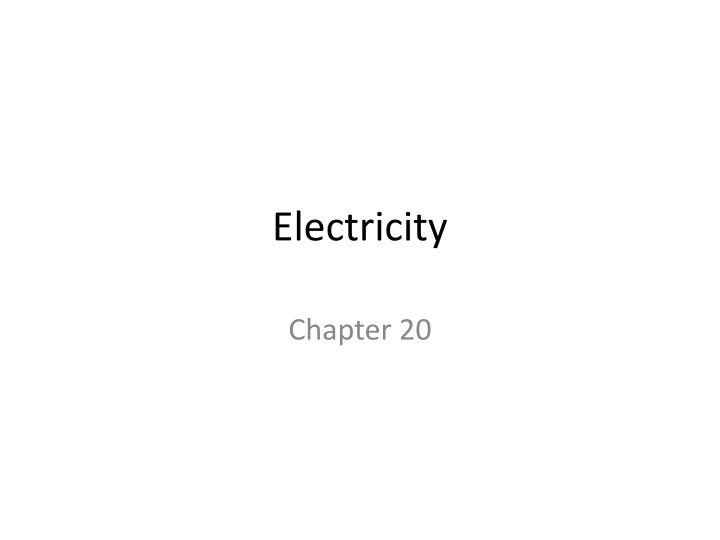

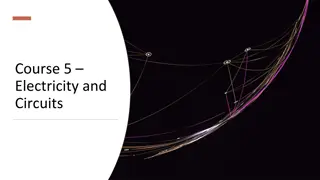
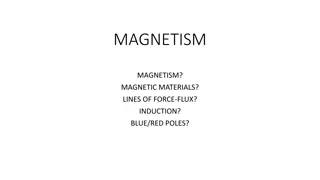
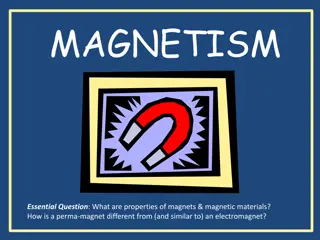
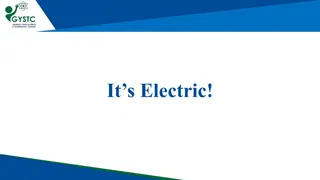
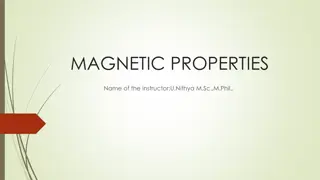
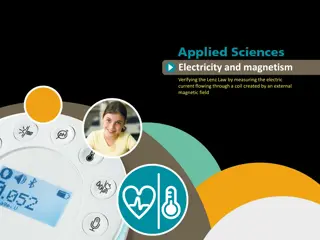
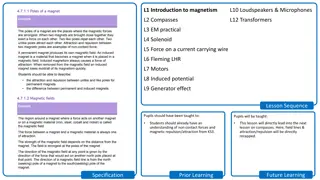
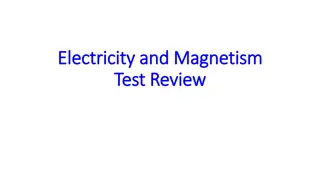


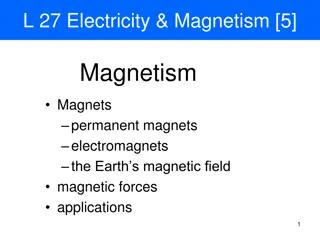
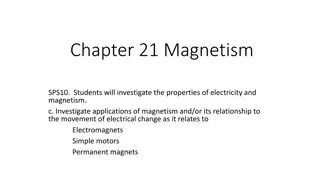
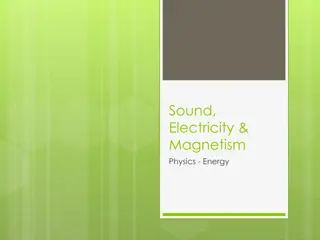
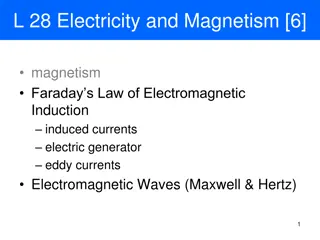
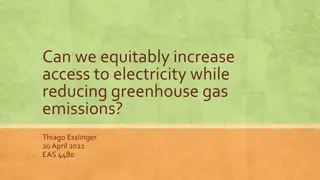
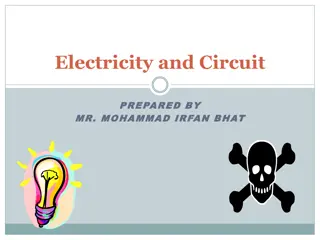
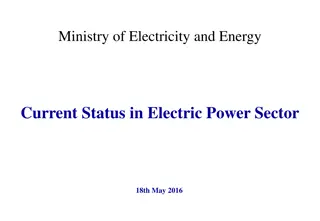
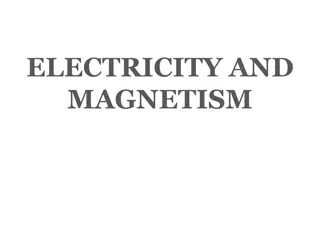
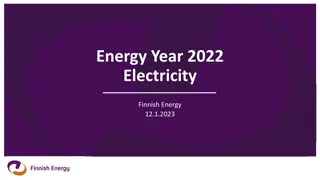
![L 24 Electricity & Magnetism [2]](/thumb/288073/l-24-electricity-magnetism-2-ppt-presentation.jpg)
